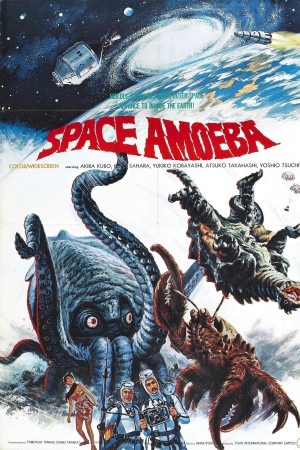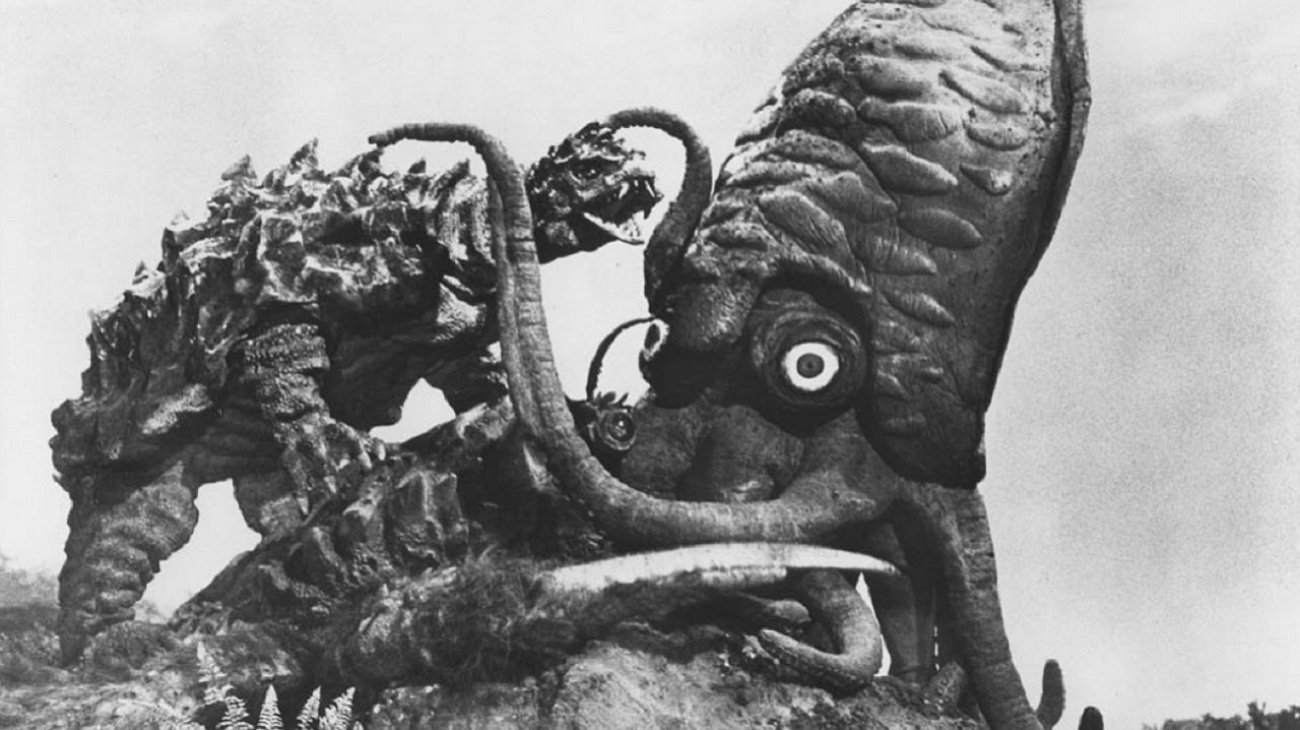
Review All Monsters! - Killer krabs from outer space
Through no fault of its own, Space Amoeba - initially released in English as Yog, Monster from Space, and given the brisk Japanese title Gezora · Ganime · Kameba: Decisive Battle! Giant Monsters of the South Seas - has the feeling of a great, epoch-marking film. It was the first Toho daikaiju eiga released in the 1970s, coming out in August of 1970; that also happens to make it the first one made after the death of Tsuburaya Eiji, the great visual effects director who hadn't taken too active a role on most of the company's tokusatsu in several years, but was nevertheless a spiritual guide on many of them. It was the last Toho daikaiju eiga until the 1990s that didn't feature Godzilla in any capacity (and its monsters were never introduced into any later Godzilla vehicle); it was the last film directed by the great Honda Ishirō for several years, as he turned his attention to television.
It is also really not a movie that you want to hang the onus of words like "first" and "last" on, because that makes it seem like it ought to be bigger, somehow, than just a daft alien invasion B-picture. Even if it is a spectacularly daft version of that genre, built on plot tropes that feel like they couldn't possibly still be getting a completely serious workout anywhere in the world as late as 1970. And yet, here they are: the mysterious Something that sends a human space probe crashing back to Earth, alien mind control of a human to act as the invaders' mouthpiece, a plucky photographer there to save the day, distrusting islanders, a sparkly blue space creature that turns cuttlefish into giant monsters...
I mentioned it was daft, right? You really can't overwork that word in this case: yes, the invaders, taking the form of an amorphous entity that can meld with Earth organisms - it might as well be called a "space amoeba", in the absence of a more accurate name - plan to take over the world with a building-size cuttlefish, crab, and turtle, operating from the remote Selga Island. But not so remote that a major corporation called Asian Development Company isn't planning on turning it into a new resort spot, and that's why photographer Kudo (Kubo Akira) is on the island, along with a cluster of fellow Asian Development toilers including biologist Mida Kyoichi (Tsuchiya Yoshio), embedded industrial spy Obata (Sahara Kenji), and pretty girl with no obvious job Ayako (Takahashi Atsuko). When their arrival is accompanied by the giant cuttlefish - the myth-savvy Dr. Mida identifies it as Gezora, a creature out of legend - the local islanders immediately view the Japanese intruders with fear and contempt, and that leaves the expedition with no help as they're forced to fight off the giant beast, and those which follow it, two giant crabs called Ganimes and the spiny turtle Kamoebas.
The primary feeling one gets from Space Amoeba is fatigue. Never before had Honda's direction been so slack and trite as it is here; he even indulges in that laziest trick of late-'60s and early-'70s cinema, the crash zoom. Screenwriter Ogawa Ei, writing his only daikaiju eiga, relies upon the blandest possible protagonists in the most nondescript of settings (anything interesting to be done with a South Pacific setting for a monster film had been spent by the end of Ebirah, Horror of the Deep, four years prior).Only Obata has any kind of interesting arc, though the actors certainly try their very best to put some energy and fun into the proceedings. They are given absolutely nothing to work with: that the film represents the third Toho film in a half decade to rely on "alien mind control of daikaiju" is entirely emblematic of the level of creativity on display. Even Ifukube Akira, whose scores could usually be relied upon for some measure of mood-setting and energy, is strictly on autopilot here.
Still, the overall experience is rather more fascinatingly weird than dispiritingly tired, and that owes almost everything to the three big monsters (or four - there are two Ganimes, but they're played by the same suit), created by the luckless Arikawa Sadamasa, who was absolutely never going to be a great replacement for Tsuburaya, but did his level best at working with fewer resources to create something distinctive, if not entirely great. Certainly, Gezora is one of the most vividly suit-ish suits Toho ever put onscreen, its mass of shaky tentacles failing entirely to hide Nakajima Haruo's legs (there are two of what I can only describe as tentacle boots coming straight down from the creature), and the whole thing looking very much like a plush toy. But damned if it isn't eye-catching, and thoroughly unlike anything you're apt to have seen anywhere else. Ganimes is a far more effective giant crustacean than Ebirah ever dreamed of being, and Kamoebas - ah, now Kamoebas is a monster! A vicious, reptilian at the end of a freakishly phallic head, covered in spikes, he's genuinely threatening in a way that no new kaiju had been since King Ghidorah, though it must be confessed that the shape of the suit made it inflexible to a degree that the big action moments have to be implied rather than shown.
Memorable kaiju across the board, then, if not for exclusively positive reasons. It helps the film out considerably, therefore, that they're so present, occupying a surprisingly huge percentage of the running time. Perhaps this is because Honda recognised that nothing else in the film was terribly interesting, and there needed to be something to keep it moving; certainly the monsters are only a distraction from the thin characters and arbitrary plotting, and not a real fix. Still, better a kaiju film with great monsters and lousy everything else than one with lousy monsters on top of nothing else being very interesting, as the previous year's All Monsters Attack teaches us; Space Amoeba is a pretty limp, banal affair overall, but when it works, it's pretty energetic fun at the most basic level of the genre. And it works considerably more often than its overall tepid construction seems like it should permit.
It is also really not a movie that you want to hang the onus of words like "first" and "last" on, because that makes it seem like it ought to be bigger, somehow, than just a daft alien invasion B-picture. Even if it is a spectacularly daft version of that genre, built on plot tropes that feel like they couldn't possibly still be getting a completely serious workout anywhere in the world as late as 1970. And yet, here they are: the mysterious Something that sends a human space probe crashing back to Earth, alien mind control of a human to act as the invaders' mouthpiece, a plucky photographer there to save the day, distrusting islanders, a sparkly blue space creature that turns cuttlefish into giant monsters...
I mentioned it was daft, right? You really can't overwork that word in this case: yes, the invaders, taking the form of an amorphous entity that can meld with Earth organisms - it might as well be called a "space amoeba", in the absence of a more accurate name - plan to take over the world with a building-size cuttlefish, crab, and turtle, operating from the remote Selga Island. But not so remote that a major corporation called Asian Development Company isn't planning on turning it into a new resort spot, and that's why photographer Kudo (Kubo Akira) is on the island, along with a cluster of fellow Asian Development toilers including biologist Mida Kyoichi (Tsuchiya Yoshio), embedded industrial spy Obata (Sahara Kenji), and pretty girl with no obvious job Ayako (Takahashi Atsuko). When their arrival is accompanied by the giant cuttlefish - the myth-savvy Dr. Mida identifies it as Gezora, a creature out of legend - the local islanders immediately view the Japanese intruders with fear and contempt, and that leaves the expedition with no help as they're forced to fight off the giant beast, and those which follow it, two giant crabs called Ganimes and the spiny turtle Kamoebas.
The primary feeling one gets from Space Amoeba is fatigue. Never before had Honda's direction been so slack and trite as it is here; he even indulges in that laziest trick of late-'60s and early-'70s cinema, the crash zoom. Screenwriter Ogawa Ei, writing his only daikaiju eiga, relies upon the blandest possible protagonists in the most nondescript of settings (anything interesting to be done with a South Pacific setting for a monster film had been spent by the end of Ebirah, Horror of the Deep, four years prior).Only Obata has any kind of interesting arc, though the actors certainly try their very best to put some energy and fun into the proceedings. They are given absolutely nothing to work with: that the film represents the third Toho film in a half decade to rely on "alien mind control of daikaiju" is entirely emblematic of the level of creativity on display. Even Ifukube Akira, whose scores could usually be relied upon for some measure of mood-setting and energy, is strictly on autopilot here.
Still, the overall experience is rather more fascinatingly weird than dispiritingly tired, and that owes almost everything to the three big monsters (or four - there are two Ganimes, but they're played by the same suit), created by the luckless Arikawa Sadamasa, who was absolutely never going to be a great replacement for Tsuburaya, but did his level best at working with fewer resources to create something distinctive, if not entirely great. Certainly, Gezora is one of the most vividly suit-ish suits Toho ever put onscreen, its mass of shaky tentacles failing entirely to hide Nakajima Haruo's legs (there are two of what I can only describe as tentacle boots coming straight down from the creature), and the whole thing looking very much like a plush toy. But damned if it isn't eye-catching, and thoroughly unlike anything you're apt to have seen anywhere else. Ganimes is a far more effective giant crustacean than Ebirah ever dreamed of being, and Kamoebas - ah, now Kamoebas is a monster! A vicious, reptilian at the end of a freakishly phallic head, covered in spikes, he's genuinely threatening in a way that no new kaiju had been since King Ghidorah, though it must be confessed that the shape of the suit made it inflexible to a degree that the big action moments have to be implied rather than shown.
Memorable kaiju across the board, then, if not for exclusively positive reasons. It helps the film out considerably, therefore, that they're so present, occupying a surprisingly huge percentage of the running time. Perhaps this is because Honda recognised that nothing else in the film was terribly interesting, and there needed to be something to keep it moving; certainly the monsters are only a distraction from the thin characters and arbitrary plotting, and not a real fix. Still, better a kaiju film with great monsters and lousy everything else than one with lousy monsters on top of nothing else being very interesting, as the previous year's All Monsters Attack teaches us; Space Amoeba is a pretty limp, banal affair overall, but when it works, it's pretty energetic fun at the most basic level of the genre. And it works considerably more often than its overall tepid construction seems like it should permit.
Categories: action, daikaiju eiga, japanese cinema, science fiction







